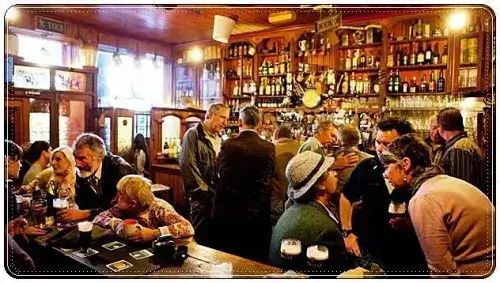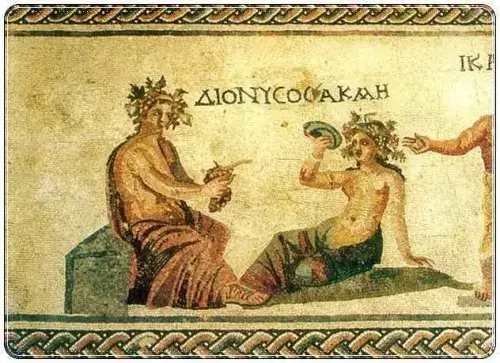Drinking Culture. Drinking alcoholic beverages is harmful and supposedly unacceptable. That’s the general notion, isn’t it? And yet, we drink! Some in moderation, others excessively.
It might be interesting to explore how different nations have adopted this so-called vice.
The Drinking Culture.
Historians do not have a definitive answer as to when and under what circumstances alcohol first appeared. Many nations, even those unfamiliar with fire, already knew about alcohol. The tradition of consuming alcohol is ancient.
Understanding this can provide insight into society as a whole.
Drinking Culture in an English Pub.
If you’ve ever been to England, you’ve probably noticed the chaotic crowd inside and outside pubs. However, there are certain rules within this apparent disorder.
In England and some other countries (such as Ireland), it is customary to drink in rounds. On one hand, this is a strictly regulated social ritual; on the other, it resembles a game.
The basic principle of drinking culture is simple. A group of friends goes to a pub, each ordering drinks and paying for them in turns. If there are six people in the group, the so-called opener (the first in line) buys a drink for everyone.
The next five rounds are free for them until their turn comes again. Everyone is expected to order drinks of approximately the same value.
It is not acceptable to make unusual or overly expensive orders. If the evening ends before someone’s turn comes up, they pay for the first round next time.
A “Proper” Drinking Session!
Social anthropologist Keith Fox, in his article “Observing the English Language,” notes that these rules reduce the risk of conflicts among drinking companions.
Despite this, the United Kingdom has even attempted to curb this tradition.
It leads to higher alcohol consumption. For example, drinking in rounds was prohibited during World War I from 1916 to 1919.
Where Does Irish Whiskey and the “E” Come From?
Irish whiskey is considered one of the first strong alcoholic beverages in Europe, dating back to the 12th century. Irish monks brought distillation techniques from their travels in Southern Europe in the 11th century and continuously improved them.
However, there is little historical data on medieval Irish distilleries.
The earliest mention of whiskey in Ireland dates to 1405. By 1556, whiskey production had spread across Ireland. The English Parliament attempted to regulate its production by introducing licensing requirements.
However, these attempts met with little success. Since then, Irish whiskey has been categorized into “parliamentary whiskey” (legally produced) and poteen (from the word “poitín” – “small still”). By the 19th century, small illegal distilleries had been eradicated, and legal distilleries continued to expand.
At its peak, Dublin became the largest whiskey producer in the world, producing 45 million liters annually. To distinguish Irish whiskey from Scotch whiskey (which at the time had a poor reputation), they decided to add an “e” to the name.
Today, this spelling distinction remains, signifying two different products.
Scottish whiskey is typically made from malted barley, distilled twice, and aged for at least three years in oak barrels. Irish and American whiskey is smoother and more neutral in flavor due to triple distillation.
The Pirate’s Drink, Rum.
Rum production is closely tied to sugarcane plantations, which require abundant sunlight, water, and labor—particularly in Jamaica and other Caribbean islands.
From the early 17th century, European colonists in these regions began processing sugarcane. Thousands of enslaved people were brought in to work under harsh conditions.
Soon, colonists discovered that molasses (thickened cane juice) fermented naturally, producing a strong alcoholic drink that brightened their otherwise grim existence.
By the late 17th century, missionaries introduced distillation techniques. Initially, the fermented liquid was distilled for medicinal purposes.
Later, people began drinking the distilled spirit recreationally. African slave traders accepted rum as payment for new captives. Rum, along with sugar, became a major export product of the Caribbean region.
Why?
First, unlike beer and wine, rum could be transported over long distances without spoiling. Second, it was stronger yet cheaper than brandy (as it was made from industrial waste).
When the British took control of Jamaica, the British navy adopted rum as its preferred drink. According to naval regulations, sailors were given a half-pint (about 280 milliliters) of rum daily.
The drink was believed to prevent scurvy and other illnesses.
Vice Admiral Edward Vernon, nicknamed “Old Grog,” ordered that the rum ration remain unchanged but be diluted with water. This watered-down version became known as grog—named after Vernon’s moniker.
Drinking Culture and Pirates – What’s the Connection?
Firstly, the Caribbean region was a hotspot for piracy. It was here that pirates attacked and looted ships and trade vessels.
Secondly, many pirates were former sailors or crew members of merchant ships.
They continued their habit of drinking rum. By the 19th century, the image of the pirate with an essential bottle of rum was immortalized by Robert Louis Stevenson in his novel Treasure Island.
Scottish Whiskey.
Whiskey-like drinks emerged in medieval Scotland and were initially used for medicinal purposes.
Monks and alchemists were responsible for distillation, and the whiskey-making process was considered almost magical. The name itself is derived from aqua vitae (Latin for “water of life”).
Historical records mention Scottish whiskey for the first time in 1494. The drink’s rise to fame began in the 19th century. In 1822, King George IV of Great Britain visited Edinburgh, becoming the first reigning monarch to visit Scotland.
The visit was organized by Sir Walter Scott, who dressed the king in a kilt and ensured he was served Scottish whiskey. The king appreciated the drink, which elevated its status and increased its popularity among Europeans.
Drinking Culture in the Caucasus.
Why is the “toastmaster” the central figure at a Caucasian feast?
The first thing that comes to mind regarding Georgian celebrations is their deep-rooted traditions. These customs trace back to ancient times. Georgia is home to some of the earliest evidence of winemaking, and the toastmaster is often associated with the ancient Colchian kingdom.
Excavations in western Georgia uncovered a small bronze amulet from the 5th-7th century BCE depicting a man holding a wine horn.
Historians believe that the role of the tamada (toastmaster) is a much later, medieval phenomenon. Traditional feasts symbolized devotion to God, and the toastmaster acted as a spiritual guide. In the past, young men were trained from childhood to master the art of toasting.
In the highlands, during religious and ritual celebrations, the toastmaster was not appointed; instead, the clan elder assumed the role.
The toastmaster had significant influence over the feast. Guests needed permission before leaving, and only the toastmaster could initiate toasts. Others could only expand on the theme.
For example:
• The first toast is for God or the world.
• The second is for parents or the homeland.
• The third is for those who are no longer with us, and so on.
A skilled toastmaster is both an improvisational poet and a good organizer. They must gauge how much guests have drunk and adjust the drinking pace accordingly.
In Georgian culture, praising guests is not considered flattery but a way to make people better.
Drinking Culture in Russia.
In ancient Russia, feasts were held across all social classes. The meal at the table was accompanied by alcoholic beverages. These feasts followed specific rules.
The host would cut bread and serve it to guests with salt, followed by drinks.
Wine was consumed only on special occasions, while nourishing mead was the primary beverage. This drink had little in common with modern mead.
Honey was mixed with lingonberries, cherries, or raspberries. The juice was stored for several years in barrels or open containers.
Sometimes, hops were added to the drink. From the 17th century onwards, mead began to be replaced by vodka— a simple distillate made from rye.
Russian feasts were always a kind of playful battle between the host and guests. The host was determined to feed and intoxicate the guests, while the guests were expected to resist and accept only out of politeness.
Many have likely heard the famous phrase when vodka is offered, and someone refuses:
“Ты что, меня не уважаешь!”
(“What, you don’t respect me?!”)
At the same time, one was expected to drink properly—”not sip like a chicken.” Those who eagerly ate and drank demonstrated their respect for the host.
If the host personally sent food and a cup of drink to someone at the table, it was mandatory to stand up, bow, and empty the cup to the bottom.
Old traditions persisted until the reforms of Peter I, when assemblies were introduced. Then, food became secondary, while dancing, gambling, and private conversations took center stage.
At the same time, the tradition of confrontation between host and guests remained.
For example, the tradition of penalty glasses became widespread at assemblies. At gatherings attended by Peter I, a 1.5-liter “Great Eagle” goblet was used.
This goblet had to be emptied completely!
By the way, many drinking traditions in Russian culture have survived to this day. Which ones do you know?
Latvians.
Not much to say. We love beer. So do all the people living around the Baltic. As for traditions, Jāņi (Midsummer) deserves an entire epic.
Have a great day!







Yes, drinking is not good – I mean alcohol, but it’s better than using drugs.